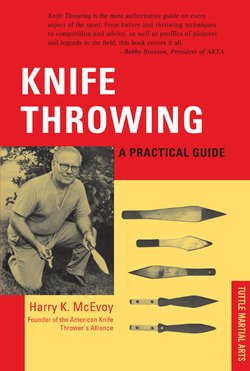Читать книгу Knife Throwing - Harry K. McEvoy - Страница 12
ОглавлениеHOW TO THROW A KNIFE
It has been pointed out that knife throwing is fun. It is also easy to learn the techniques of throwing a knife providing the thrower has the ability to hurl a rock, stick, or baseball.
Handle grip
Before any sportsman can learn to throw a knife properly, however, he first must know how to grip the weapon. He will start out using either the handle grip or the blade grip, depending upon which style of throwing-knife he has chosen.
Since the handle-throwing type is the easiest to throw, it is this model that will be considered first.
After you have selected a knife of the proper length, weight, and balance-one that "feels" right to youyou should grasp the handle firmly in the same natural manner in which you would normally grasp a hatchet handle. The ball of your thumb is pressed against the rivet nearest the hilt, and your fingers are curled firmly and comfortably around the handle (Fig. 6). With a target in position and you standing at a distance of approximately 15 feet from the hull's eye, you should now be ready to try that first practice throw.
Keeping the plane of the knife vertical as it leaves your hand, pitch the weapon hard and fast with an overhand throw, letting it slip out of your hand when you instinctively feel that it is lined up properly with the target.
The results of that first throw are not too important because, before you can expect to attain proficiency as a knife thrower, it is necessary to understand thoroughly the mechanics of the throw and the simple techniques involved.
Blade grip
When throwing by the blade, assuming you have selected a weapon designed and balanced for this style of throwing, you grasp the blade of the knife firmly-cutting edge away from the palm of your hand-with the thumb pointed directly towards the handle. Your first, second, and third fingers are lined up on the opposite side of the blade, while the little finger can be curled up and out of the way. It is too short to be of much help anyway (Figs. 7-9).
From the bottom finger to the tip of the point, an inch or so of steel should protrude. This will bring the point to within i inch of the crease in your skin where hand and wrist are joined. It will also permit much better control of the knife than if you grasped it at the extreme tip of the point.
The throw is then made with the plane of the knife horizontal. This is the method recommended for the thrower who is using a weapon with one sharp edge. With a professional style of throwing-knife, of the design favored by true professionals of the art, there are no sharp edges involved. The blade throw is practically the same as the handle throw, in which case, of course, the knife is always thrown with the plane of the blade vertical (Figs. l 0, 11). But professional throwing techniques differ somewhat from those used by sportsmen and will be considered in depth in Chapter VIII.
The game of baseball offers the best example of illustrating the basic points of knife throwing, because in the overhand pitch the mechanics of the movements are about the same. Four elements are involved: stance; wind-up; throw; and follow-through.
Using the handle throw, the handle is grasped by the method described previously-firm grip, ball of thumb on rivet nearest the hilt, and fingers curled naturally around the handle. The plane of the blade should be vertical when it leaves your hand.
Stance
Your stance is like that of a righthanded baseball pitcher-right foot forward on the "mound," at a distance of four or five paces or approximately 15 feet from the target (Fig. 12).
Wind-up and throw
With a natural wind-up for a hard, fast throw with full power and velocity, you swing your body and left leg forward in the throwing movement while your knife arm swings back, up, and forward in a smooth circular sweep toward the target. The throw is very similar to an overhand pitch or cracking a bull whip, but without the usual wrist snap. The knife should slip from your hand just before you reach the end of your swing, at the split second you instinctively know it is lined up with the bull's-eye (Figs. 13, 14).
Follow-through
